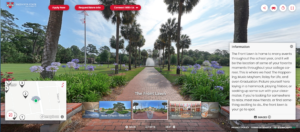We live in a world where engagement can make or break your communications efforts. In fact, your organizations might succeed or fail based on how well it grabs your audience’s attention. Then, that leverages attention into tangible business benefits. Where does virtual tour software fit into the picture?
Development comes with a consistent array of new communications opportunities. It might not shock you to know that we’re especially interested in going deep on one of them. Namely, interactive, virtual tours.
We believe in the power of virtual tours. But that doesn’t mean they’re right for every type of organization. An eCommerce merchant or finance startup, for instance, might not find the traditional marketing use of virtual tour software all that beneficial.
So let’s get specific. Look for one of these 9 signs to determine whether your business can benefit from virtual tour software.

1) Your Physical Space Matters to Your Audience
It might sound like an obvious parameter, but it’s still worth mentioning. Virtual tours are specifically designed to help communications efforts with audiences that care about your organization’s virtual space. That can happen in any number of ways:
- Colleges and universities look to show off their campus to prospective students, who will make it their home for the next four years.
- Hotels and attractions hope to leverage their space for prospective tourists and visitors, who want to know what it looks like before booking a trip.
- Warehouses and server farms can use virtual tours to onboard and train prospective employees in the complexities the space brings with it.
And those are just some examples. The rule is simple: if your physical space makes a tangible difference in your audience’s participation, virtual tour software can help you prompt that action.
2) You’re Struggling to Replicate in-Person Exposure in the Digital Space
The second sign is often, but not always related to the first. COVID-19 has brought 180-degree changes in marketing and communications for a wide range of B2B and B2C industries. COVID has suddenly taken away in-person channels like trade shows, facility and campus visits, and more. Not every business has been able to adjust seamlessly.
A well-crafted marketing plan, refined over years, suddenly no longer holds promises as audiences stop their in-person visits and communications touch points. That’s where a virtual tour can help, allowing you to build digital experiences that approximate the engagement and immersion otherwise reserved for more personal, physical connections.
3) Your Audience Keeps Asking for More (Virtual Tour Software)
You might account for either of the above signs with a number of visual opportunities. Photos and videos of your physical space can go a long way towards showcasing the space and enticing your audience to visit. At the same time, that process might not be enough. In fact, your audience might ask for more, in more ways than one:
- They might look for more tangible information about your space, such as the walking distance between buildings. It’s not typically feasible to create new videos every time a request comes up.
- They might look for clear next steps that allow them to learn more about a topic in question. This creates natural movement from the awareness to the consideration stage in the process.
- They might look for an experience that can easily integrate within their expectations. This allows for on-demand navigation or custom stops depending on the information they’re interested in.
We live in an age of on-demand digital experiences. Almost two thirds of consumers now expect custom content they can manipulate according to their specific needs. This is preferred over pre-curated content that might not be relevant to them. If you find them keep asking for more depth, detail, and customization, a virtual tour might be right for you.
4) Your Online Presence is Largely Static
The fact is, in today’s digital environment, websites in many industries can no longer afford to be static. They’re no longer virtual “billboards” that simply present your company’s information, products, and services. These static presences tend to lose out to more dynamic experiences that engage and immerse your users.
Fortunately, a virtual tour can offer at least part of the solution. It offers an element of dynamic content that can permeate throughout your website. For instance, you can embed the tour on your homepage or About Us page. Furthermore, you can embed individual tour stops on various parts of the website relevant to the specific subtopic.
Moreover, promoting the virtual tour through your digital channels can benefit your online presence beyond your website. You can build and expand the interactivity of your social media presence, email marketing, and other channels. Additionally, this removes the static nature that customers are no longer interested in.
5) You’re Looking to Convert Attention to Leads and Customers
As established above, a virtual tour is great in getting your audience’s attention. But it doesn’t end there. With the right virtual tour software, you can convert that attention into tangible marketing and business outcomes. This then drive revenue and maximize its return on investment.
That process tends to happen through direct and indirect calls to action. Direct calls to action are buttons, placed strategically according to the most natural next steps, prompting your audience to learn more or otherwise convert. Indirect calls to action can be visuals, embedded links, or even targeted narration that prompts your audience to take that next step.

6) Telling Your Brand Story is Too Complex for Words
Recent years have seen a significant rise in brand storytelling, the process of turning your background and unique value proposition into a compelling story your audience wants to know more about. Furthermore, that story may include a wide range of components:
- Your organization’s history
- Your core mission and values
- The challenges your brand seeks to overcome
Audiences love this approach to marketing. More than half will become more likely to buy from you. Almost half will share it. And an astonishing 92% want your ads to look like stories.
Unfortunately, for many brands, telling that story is complex. It becomes impossible to write it all down. A virtual tour solves that problem, enabling brand storytelling in an immersive format.
7) Your Employee Training Tends to Fall Flat
Virtual tours don’t just have to solve business problems for external audiences. They can be just as important for training purposes, especially when in-person opportunities are limited.
When it comes to productivity and employee engagement, effective training can make all the difference. Unfortunately, that also means the opposite is true as well. Unproductive training can lead to significant performance issues.
Virtual tours are no magic training bullets, but they might just be a difference maker. Their engaging nature, combined with engaging opportunities for your audience to immerse themselves into the space, can lead to better training and ultimately, increased productivity.
8) You Need Visuals to Tug on Your Audience’s Heart Strings
An age-old idiom in marketing is that emotion will always trump rational thinking. That’s supported by research stating that 95% of purchasing decisions, even for large commitments, are emotional. Additionally, you need that emotional connection to your audience to truly get your message across.
Good to know, then, that there is nothing better to tug on your audience’s heart strings than virtual tours. By virtually transporting your audience into your space, you can make them feel like they’re there. Furthermore, your narration can give them important background information in an engaging way. Supplemental visuals, like video content, can further increase that emotional connection.
9) Your Virtual Tour Software Audience is Spread Out Geographically
The final sign you might need virtual tour software is purely logistical. Your target audience may simply be too spread out to ever benefit from an in-person visit. Imagine the case of a resort hotel, trying to attract tourists from all over the world, needing to rely on its visuals and virtual experiences for a true sense of what staying on its premises will be like.
The benefits of a virtual tour in this scenario are natural. Additionally, you can bring your space to your audience, showcasing in an immersive fashion that’s almost as good as a physical visit.
Find the Right Virtual Tour Software to Optimize Your Digital Communications
If you find yourself seeing one or more of the above signs, you might be in the market for a new virtual tour that can enhance your website and online presence. Furthermore, the next step is making sure that the virtual tour software you pick is right for your industry, and helps you achieve your business goals.
That’s where we come in. Concept3D prides itself in providing a virtual tour platform applicable to a wide range of industries, with clients ranging from healthcare to higher education. Contact us to learn more about a potential partnership, and how you can leverage your virtual tour to optimize your digital communications.

